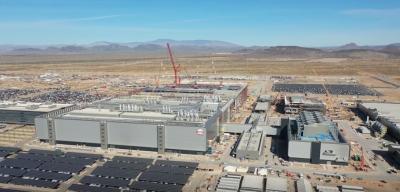Construction continues on a $2.8 billion, 582-megawatt energy facility on 3,000 acres (1,214 h) in Kemper County, Miss., about 20 mi. north of Meridian. The plant uses electric power plant technology called integrated gasification combined cycle (IGCC).
“Mississippi Power has a need for a new base load generation resource by 2014. Base load generation runs 24/7,” said power company spokesman Jeff Shepard. “It’s been nearly 30 years since Mississippi Power last built base load generation to meet the needs of our customers.”
Six years ago, a comprehensive generation study and evaluation of financial, environmental and technological assessments identified the Kemper County energy facility as the best new generation resource for meeting a growing customer demand, according to the power company. After two phases of public hearings, the Public Service Commission issued an order in June 2010, clearing the way for the plant to be built.
In 2012, with construction at the half-way point, crews are doing their best to stay on schedule after completing a crucial step. The power company said the Kemper plant will use the most advanced gasification technology in the world. Instead of burning lignite directly to make electricity, the IGCC process sends lignite through a device called a gasifier. While subjected to high temperatures and high pressure in the gasifier, it undergoes a chemical reaction.
“In mid-September, we safely reached an important construction milestone when the first pieces of the gasifier were installed,” said Shepard. “The gasifier is the portion of the power plant where the fuel source, lignite, will be converted into a synthesis gas, which will be used to generate electricity. The gasifier weighs approximately 550 tons, which is equivalent to two Statues of Liberty. It will take 18 lifts to complete installation of the two gasifiers.”
The energy facility has emissions controls built in and will incorporate carbon capture technology from the first day of operation. Sixty-five percent of the carbon dioxide produced at Kemper will be captured and shipped via pipe to be used for enhanced oil recovery near Heidelberg, Miss.
“That 65 percent capture rate is equivalent to a similarly-sized natural gas plant,” said Shepard. “Contracts for the sale of sulfuric acid and anhydrous ammonia are currently being finalized. Revenue generated from the sale of these byproducts will directly benefit customers by lowering the overall cost of the facility.
Aquatech International, a water purification technology provider, was awarded the contract to provide services for the plant. Mississippi Power has a renewable contract to purchase treated effluent, also known as gray water, from the city of Meridian. The effluent will be piped to the plant from two water treatment facilities, collected in a reservoir and then treated through the purification system. The plant requires approximately seven million gallons of water per day. The plant will collect rainwater as a secondary source of cooling water, which also will be purified before it is used.
“This facility will be a zero discharge facility, which means that none of the process water from the plant will be discharged into streams and watersheds,” Shepard explained. “For cooling water, the company has signed a long-term contract with the city of Meridian for the use of its treated effluent water. The water will be piped from Meridian to the plant site, which is approximately 20 miles. The city gets an additional revenue source and avoids costly facility upgrades, and the project gets the most economical source of water.”
Robby Eubanks, project coordinator, Performance Contractors Inc., pointed out, “As a contractor, our first priority is executing a safe project, making every effort to eliminate all construction hazards and preventing any of our employees from being injured on the project. Performance Contractors is responsible for the installation of the gasifier structure, the gas cleanup and by-products portion of the facility, as well as construction of the water treatment/waste water treatment facility.
“The installation of the gasifier on this project is achievement of a major milestone in the construction phase of this project,” Eubanks said. “As with all projects, the installation of major equipment provides the opportunity for other construction disciplines such as structural steel, piping and electrical/controls to proceed with installation, and supports the overall completion target for the project.”
Regarding the actual construction Eubanks said, “We are using heavy lift cranes and transporters for installation of the major process equipment. This project is using standard forms of construction materials typically utilized in power, process and industrial facilities. As with any project, the contractor is responsible for protecting the site and environment during construction. We are required to develop and comply with a very strict environmental, health and safety plan.”
Equipment being used for the project includes 30-, 40-, 60-, 80- and 125-ft. aerial personnel lifts, air compressors, 160-ton (145 t), 200-ton (181 t), 275-ton (249 t) and 300-ton (272 t) crawler cranes, dozers, 5,000-lb. (2,267 kg), 8,000-lb (3,628 kg), 9,000-lb (4,082 kg), 10,000-lb (4,535 kg), 11,000- lb. (4,989 kg) and 30,000-lb. (13,607 kg) forklifts, 15-ton (13.6 t), 60-ton (54 t), 65-ton (58 t) and 80-ton (72 t) rubber tire cranes, welding machines, excavators and generators.
Construction materials used on the project include low alloy steel pipe, carbon steel pipe, stainless and high alloy steel pipe, copper or copper-based alloy pipe, fiberglass reinforced polyester (FRP) pipe, thermoplastic polymers (HDPE, PE) pipe, cast or ductile iron pipe, thermosetting polymers (PVC, CPVC, ABS) pipe, lined carbon steel pipe, nickel alloys pipe, B7 and B8 bolts/nuts, along with garlock and spiral wound gaskets.
Performance Contractors has been involved with on-site construction on the plant since January 2012 and expects to finish its scope of work in February 2014.
“As with all construction projects adverse weather conditions can play a key role in the success of a project,” said Eubanks. The project team, including the owner and contractor, develop plans to mitigate any impacts adverse weather may have on this project, including working weekends to offset any lost work days due to weather. Project schedules are monitored daily, and any construction schedule variances are managed to minimize any schedule slippage due to weather conditions.”
Eubanks said, “We currently have approximately 1,350 people on our construction payroll. There are still many large equipment components remaining to be installed, all of which are scheduled sequentially during the next six to nine months. This project provides a tremendous work opportunity for a large number of construction craftsmen for the next 15-plus months. Once completed and in operation, this project will place Mississippi Power and the state of Mississippi in a leadership position in the power industry for years to come.”
Mississippi Power officials are calling the project a major economic boost for the state. Reportedly, as many as 3,000 direct and indirect jobs have been created during construction, along with more than 300 permanent positions. More than 2,000 workers have been on site, with up to 2,500 workers on the job during peak construction. Additionally, more than 250 Mississippi companies are providing construction, equipment, material or professional services.
According to Faye Wilson, executive director of the Kemper County Chamber of Commerce, “This is an exciting project for Kemper County in that there’s now growth in our county after years of no growth. The plant is hiring local whenever possible and those hires spend that money in the county. Several local businesses have done very well with out-of- county people who work at the plant. Every rental spot at Kemper Lake is filled, and restaurants in DeKalb are busy.
“The Chamber is confident the plant will live up to the all promises and pledges they have made to the county. I have visited the plant site twice, and it’s truly an amazing thing to see.”
Craig Hitt, executive director of the Kemper County Economic Development Authority, added, “This project would be exciting for any area across the South, given its size. For this region, it is and has been the object of discussion for the past few years. Now that construction is well underway, many local citizens are not only seeing the progress, but also are benefiting from the activities in their own communities. With the construction phase, many local businesses are benefiting from all the construction workers who are living near the site. In the future as the plant becomes operational and the permanent jobs are filled we hope to see many local people permanently employed. Many people across the state of Mississippi and maybe even the Southeast are more familiar with Kemper County now, due to the attention given to this project.”
Mississippi Power also has signed long-term contracts to sell the by-products from the gasification process. Revenue from the sale of these by-products will lower the overall costs for customers by approximately $50 million annually once the plant is operational.
Building the new plant, however, is not without controversy.
Attorneys for Mississippi Power and the Sierra Club have been battling in court, debating whether the economics of the plant justify construction at this time. The plant is expected to be about three-fourths complete by the time a decision is reached.
“When Mississippi Power was looking at options for new base load generation, we looked at all options,” said Shepard. “The Kemper County energy facility was the best choice for our customers during the approval process, and it remains the best choice. This facility will allow us to provide safe, reliable and environmentally responsible electricity to our customers for the next 40 years.”
Mississippi has a four-billion-ton reserve of lignite, with the Liberty Mine in Kemper County providing a significant portion. The Kemper energy facility will use approximately 375,000 tons of the locally mined lignite per month, which translates to roughly 150 million tons over the next four decades.
Mississippi Power, a Southern Company subsidiary, serves roughly 186,000 customers in almost two dozen southeast Mississippi counties.
Today's top stories















